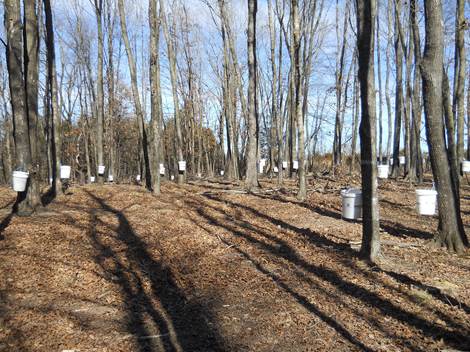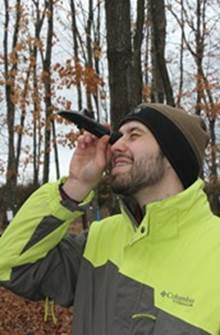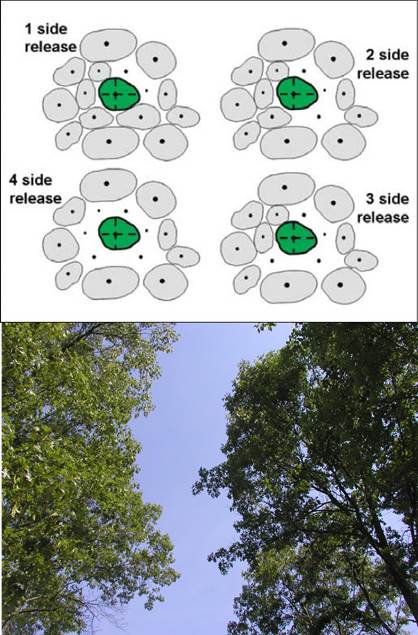AgEBB-MU CAFNR Extension
Green Horizons
Volume 22, Number 2
Spring 2018
Agroforestry
How to Manage a Sugar Bush
By Hank Stelzer| University of Missouri Extension, School of Natural Resources
A sugar bush refers to a forest stand dominated by sugar or black maple trees that can be tapped to yield sap which can then be processed into maple syrup. This article is the first of two that will appear in Green Horizons on producing maple syrup in Missouri, and will focus on managing the trees for maximum sap production. The second piece, to appear in the fall issue, will focus on how to collect and process the sap.
Some, if not most, foresters (and perhaps a few landowners) view sugar maple as a weed. By definition, a weed is a plant growing where it is not wanted. But, in a sugar bush, sugar maple IS wanted. This should serve as a reminder that 'beauty is in the eye of the beholder' or in this case 'the objectives of the landowner'.
 |
A sugar bush at the CAFNR Baskett Research and Education Center near Ashland, MO. |
The structure of the sugar bush refers to the numbers, kinds, and ages of trees present at different stages of its development. Since sugar bushes should be managed for the largest volume of sugar-rich sap over a given area, a goal is to have an optimum number of sugar maple trees on the site that produce high volumes of sweet sap.
It is important to know which trees will produce the largest volume of sugar-rich sap. Desirable trees are vigorous and fast growing, with large crowns well exposed to sunlight. Trees growing one inch in diameter every two to five years yield as much as 30 percent more sap than those that grow an inch in seven to ten years.
Of two trees with the same stem diameter, one with a crown diameter 50 percent larger than the other can yield twice as much sap. Trees with greater crown length relative to height also produce more sap. In other words, trees with large crowns produce and accumulate more food energy reserves during the summer months. In turn, these reserves provide the sugar the following spring
Trees with sweeter sap usually yield larger quantities of sap. The sugar content of maple sap normally ranges from 1 to 4 percent. Sap sweetness is primarily genetically controlled. Sap-sugar content should be considered in tree selections as it will have a significant and long- lasting effect on sugarbush productivity and income. Sap- sugar content is best measured in the spring with a sugar refractometer.
 |
A refractometer is a device used to measure the sugar content of a solution, be it maple syrup or maple sap |
The amount of direct sunlight received by the crown also influences sap sweetness.Trees in the open have a higher sap-sugar content than similar-size trees in dense forests. Sugarbush management, therefore, should focus on selecting trees that produce the sweetest sap, and encouraging the development of their crowns by carefully thinning the stand.
An axiom of ecology states that the stability of a forest community is enhanced by diversity. Stands with high and low species diversity are affected differently by climatic extremes or biotic agents.
Presumably, this is the result of differences among tree species in susceptibility to these factors. A single-species sugar bush follows this axiom.
The advantages of a maple monoculture are convenience and economy of operation. However, the single species stand, and often the steps needed to create it, can lead to problems. These include rapid development of insects and disease pathogens that favor sugar maple, and gradual adverse changes (perhaps depletion) in certain nutrient relationships. Sugar maple monocultures on poor sites are often affected more adversely by these and other problems than are sugar bushes on good sites. Understandably, for economic reasons, sugar bush operators tend to encourage monocultures. Because this practice may increase susceptibility to various maple problems, it is important to monitor stand conditions and pest activities more frequently and carefully than in other forests.
Crop Tree Release
The goal of sugar bush development is to ensure sufficient numbers of well-spaced, high-quality, productive sugar maple trees. Ideally, crop trees should be chosen as early as possible as this will allow greater flexibility in tree selection. Regardless of the stage of stand development (sapling, pole, or sawtimber size), the following steps for developing a sugar bush are recommended.
Step 1, select the location of potential crop trees at a spacing of 25 to 30 feet in all directions. This should result in a stocking of approximately 64 trees per acre when they are about 12 inches in diameter at 4.5 feet or at "breast height" (d.b.h.).
 |
It is desirable to release the selected crop tree on at least two sides, preferably all four, so there is at least a 10- to 15-ft. gap between the crop tree and its nearest neighbor. This allows for a healthy, vigorous crop tree and more maple sap! |
Step 2, find the tallest maple trees with the widest and longest crowns at each of these locations. From among these candidates, choose the one with the fewest crown or stem injuries, deformities, or cankers.
Step 3, measure the sap-sugar content of the selected tree in the spring and compare it to that of other candidates at that location. If its sap is as sweet or sweeter than the others, it becomes a crop tree. If the sap-sugar content is significantly lower (by 1 percent or more), it may be advisable to repeat the selection process (steps 2 and 3) from among the other candidates.
Step 4, release the selected crop tree by removing neighboring trees whose crowns touch the crop tree. The crop tree should be released on at least two sides, preferably all four. This can be done in several steps if removing all competing trees at once would create undesirable large openings. Caution also should be taken so that the removal of non-competing trees does not create overly large openings.
Step 5, repeat release cuttings when the branches of surrounding trees once again begin to touch the crown of the crop trees. Eventually, only crop trees will remain. Once this point is reached, no further thinning should occur. Providing space for crown development allows the maximum production of sugar-rich sap with minimum disturbance to the site
Step 6, Monitor the conditions of the crop trees each year. Remove only diseased, badly damaged, or dead trees. Removing these trees will reduce sources of infection, help prevent uncontrolled damage to in-place tubing systems, allow crown expansion of the remaining trees, and encourage the development of regeneration. Should damage or the death of large numbers of trees make it necessary to regenerate the sugar bush, seek advice of a professional forester.
Should one fertilize a sugar bush? A question asked by many sugar bush operators is: can fertilization increase the growth rate and health of trees in my sugar bush? Sugar bushes do appear to be appropriate forest stands to fertilize because they generally are not large, are easily accessible, and yield an annual monetary return.
Trees need the essential elements nitrogen, phosphorus, sulfur, calcium, potassium, and magnesium, as well as several minor elements. When all of these elements are plentiful in the soil, growth (vigor) will be at a maximum. But where there is a deficiency (or excess) of even one essential element, tree growth and vigor may be impaired. Fertilization is one means of correcting such nutrient imbalances. In practice, however, fertilizing a sugar bush is risky, and results of experiments have been mixed. Negative effects usually result from using the wrong fertilizer or combination of elements, and worsening any nutrient imbalance that existed. Fertilization should be considered only when growth is poor or vigor is low, and even then it would be a last resort.
No fertilization program should be undertaken before a foliar and/or soil analysis has been conducted. Foliar symptoms may indicate deficiencies, but they are not always reliable. In addition, the severity of the deficiency and the amount of nutrient required to correct it cannot be determined from the symptoms. Moreover, because the nutrient content of the foliage varies during the growing season and, for some elements, with the location within the tree crown, a precise sampling methodology must be followed.
Generally, about 50 leaves from each of 5 to 10 trees collected in midsummer at a given height in the crown will suffice for establishing the nutrient status of a stand. Check with a specialist before sampling to learn about particular sampling requirements.
Liming the soil as a corrective measure has been suggested, but liming never has been a permanent cure for poor stand vitality. Too much lime may decrease the availability of certain nutrients and inhibit mycorrhizae, those fungi that live in close association with tree roots and enhance the ability of trees to take up nutrients. In general, the outcome of fertilization of sugar bushes is uncertain at best, and risky if done without adequate chemical analyses of soil and foliage.
